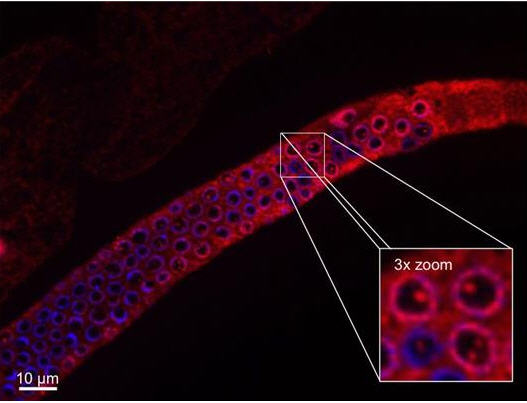New switch decides between genome repair and death of cells

Isolated germ line of C. elegans
Björn Schumacher, one of the senior authors, explains: “Within seconds after an harmful incident, different mechanisms start. In a schizophrenic way, the cell starts repairing as well as preparing for apoptosis. We identified an uncharacterized mechanism that integrates signals from the ongoing repair process and the cell death machinery.
A protein called UFD-2 forms large complexes at the breaks and verifies whether to proceed with the repair or whether it’s time to die.” In the process, UFD-2 is a point of intersection that both receives and gives signals.
The experiments were performed with the nematode Caenorhabditis elegans. “For our research we used different strains of C. elegans, including wild type and genetically modified ones. They were exposed to ionizing radiation to induce double strand breaks and then examined,” says Leena Ackermann, lead author of the study.
Schumacher adds: “The results are important to further understand how and why a cell decides to repair or to die. Is the repair still ongoing and successful or is apoptosis necessary? Cells lacking UFD-2 fail to undergo apoptosis. In humans such a situation could lead to a higher risk of a damaged cell becoming a cancer cell.”
All the proteins that play a part in this mechanism can be found in humans as well, and the findings could be highly relevant to better understanding how DNA damage leads to cancer. DNA damage is also an important driver of the aging process. Although apoptosis protects from cancer, excessive cell death can lead to tissue degeneration and aging.
The senior author Thorsten Hoppe originally identified UFD-2 as a key regulator of protein degradation. Here, UFD-2 forms regulatory centers that coordinate DNA repair and cell death. Hoppe hopes for resulting advances in tumor therapy: “The knowledge we gained from this study provides new perspectives for fighting cancer pharmaceutically. It might be possible to manipulate the well-balanced process of apoptosis and protein degradation to make clearance of tumor cells more efficient.”
The original paper was published on September 26 in Nature Structural & Molecular Biology.
Leena Ackermann, Michael Schell, Wojciech Pokrzywa, Éva Kevei, Anton Gartner, Björn Schumacher, and Thorsten Hoppe: E4 ligase–specific ubiquitination hubs coordinate DNA double-strand-break repair and apoptosis.
http://www.nature.com/nsmb/journal/vaop/ncurrent/full/nsmb.3296.html
Full bibliographic information
Leena Ackermann, Michael Schell, Wojciech Pokrzywa, Éva Kevei, Anton Gartner, Björn Schumacher, and Thorsten Hoppe: E4 ligase–specific ubiquitination hubs coordinate DNA double-strand-break repair and apoptosis.
Nature Structural & Molecular Biology
DOI: 10.1038/nsmb.3296.
For further information, please contact:
Patrick Honecker
Media Contact
All latest news from the category: Life Sciences and Chemistry
Articles and reports from the Life Sciences and chemistry area deal with applied and basic research into modern biology, chemistry and human medicine.
Valuable information can be found on a range of life sciences fields including bacteriology, biochemistry, bionics, bioinformatics, biophysics, biotechnology, genetics, geobotany, human biology, marine biology, microbiology, molecular biology, cellular biology, zoology, bioinorganic chemistry, microchemistry and environmental chemistry.
Newest articles

Compact LCOS Microdisplay with Fast CMOS Backplane
…for High-Speed Light Modulation. Researchers from the Fraunhofer Institute for Photonic Microsystems IPMS, in collaboration with HOLOEYE Photonics AG, have developed a compact LCOS microdisplay with high refresh rates that…

New perspectives for material detection
CRC MARIE enters third funding period: A major success for terahertz research: Scientists at the University of Duisburg-Essen and the Ruhr University Bochum have been researching mobile material detection since…

CD Laboratory at TU Graz Researches New Semiconductor Materials
Using energy- and resource-saving methods, a research team at the Institute of Inorganic Chemistry at TU Graz aims to produce high-quality doped silicon layers for the electronics and solar industries….



